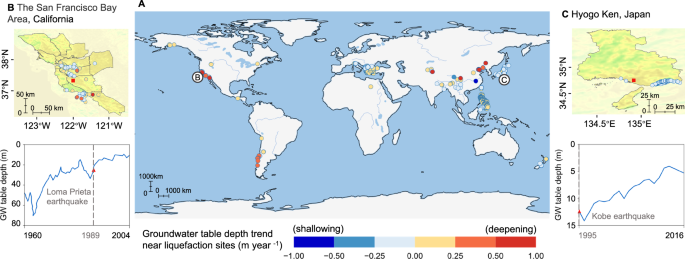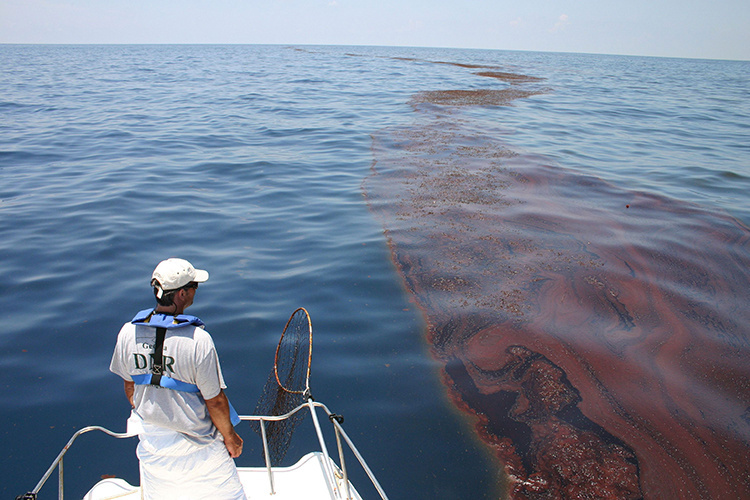Rising groundwater table due to restoration projects amplifies earthquake induced liquefaction risk in Beijing

Konikow, L. F. & Kendy, E. Groundwater depletion: a global problem. Hydrogeol. J. 13, 317–320 (2005).
Google Scholar
Qiu, J. China faces up to Groundwater crisis. Nature 466, 308 (2010).
Google Scholar
Shi, J. et al. Assessment of deep groundwater over-exploitation in the North China plain. Geosci. Front. 2, 593–598 (2011).
Google Scholar
He, C. et al. Future global urban water scarcity and potential solutions. Nat. Commun. 12, 4667 (2021).
Google Scholar
Shah, T., Molden, D., Sakthivadivel, R. & Seckler, D. The Global Groundwater Situation: Overview Of Opportunities And Challenges (International Water Management Institute, Colombo, Sri Lanka, 2000).
Famiglitti, J. S. & Ferguson, G. The hidden crisis beneath our feet. Science 372, 344–345 (2021).
Google Scholar
Hasan, M. F., Smith, R., Vajedian, S., Pommerenke, R. & Majumdar, S. Global land subsidence mapping reveals widespread loss of aquifer storage capacity. Nat. Commun. 14, 6180 (2023).
Google Scholar
Perrone, D. & Jasechko, S. Deeper well drilling an unsustainable stopgap to groundwater depletion. Nat. Sustain. 2, 773–782 (2019).
Google Scholar
Zhang, W. Eco-environmental impact of inter-basin water transfer projects: a review. Environ. Sci. Pollut. Res. 23, 12867–12879 (2016).
Google Scholar
Das, D. K. Environmental impact of inter-basin water transfer projects: some evidence from Canada. Econ. Polit. Week. 41, 1703-1707 (2006).
Jain, S. K., Reddy, N. S. R. K. & Chaube, U. C. Analysis of a large inter-basin water transfer system in India. Hydrol. Sci. J. 50, 1 (2005).
Google Scholar
Ghassemi, F. & White, I. Inter-basin water transfer: case studies from Australia, United States, Canada, China and India. (Cambridge University Press, England, 2007).
Taylor, R. G. et al. Ground water and climate change. Nat. Clim. Chang. 3, 322–329 (2013).
Google Scholar
Dong, L., Cao, J. & Liu, X. Recent developments in sea-level rise and its related geological disasters mitigation: A review. J. Mar. Sci. Eng. 10, 355 (2022).
Google Scholar
Okamura, M. & Soga, Y. Effects of pore fluid compressibility on liquefaction resistance of partially saturated sand. Soils Found 46, 695–700 (2006).
Google Scholar
Yegian, M. K., Eseller-Bayat, E., Alshawabkeh, A. & Ali, S. Inducedpartial saturation for liquefaction mitigation: Experimental investigation. J. Geotech. Geoenviron. Eng. 133, 372–380 (2007).
Google Scholar
Ulmer K. J. et al. Next-generation liquefaction database, version 2. next-generation liquefaction consortium. (2023).
Hidayat, R. F., Kiyota, T., Tada, N., Hayakawa, J. & Nawir, H. Reconnaissance on liquefaction-induced flow failure caused by the 2018 M W 7.5 Sulawesi earthquake, Palu, Indonesia. J. Eng. Technol. Sci. 52, 51–65 (2020).
Google Scholar
Unjoh, S., Kaneko, M., Kataoka, S., Nagaya, K. & Matsuoka, K. Effect of earthquake ground motions on soil liquefaction. Soils Found 52, 830–841 (2012).
Google Scholar
Long, D. et al. South-to-North Water Diversion stabilizing Beijing’s Groundwater levels. Nat. Commun. 11, 1–10 (2020).
Google Scholar
Dean, J. L. & Sholley, M. G. Groundwater Basin Recovery In Urban Areas And Implications For Engineering Projects. Engineering Geology For Tomorrow’s Cities (Dublin, Ireland, 2006).
Shintani, T. et al. Three-dimensional structure and sources of groundwater masses beneath the Osaka Plain, Southwest Japan. J. Hydrol. -Reg. Stud. 43, 101193 (2022).
Google Scholar
Bardet, J. P. & Kapuskar, M. Liquefaction sand boils in San Francisco during 1989 Loma Prieta earthquake. J. Geotech. Eng. 119, 543–562 (1993).
Google Scholar
Elgamal, A. W., Zeghal, M. & Parra, E. Liquefaction of reclaimed island in Kobe, Japan. J. Geotech. Eng. 122, 39–49 (1996).
Google Scholar
Shibata, T., Oka, F. & Ozawa, Y. Characteristics of ground deformation due to liquefaction. Soils Found 36, 65–79 (1996).
Google Scholar
Ministry of Land, Infrastructure, Transport and Tourism. Water Information System. Accessed on July 2024 from (2024).
Zhang, M., Hu, L., Yao, L. & Yin, W. Numerical studies on the influences of the south‐to‐north water transfer project on groundwater level changes in the Beijing Plain, China. Hydrol. Process. 32, 1858–1873 (2018).
Google Scholar
Beijing Water Authority. Beijing Water Resources Bulletin 2003–2016 (Beijing Water Authority, Beijing, 2016).
Gu, W., Shao, D. & Jiang, Y. Risk evaluation of water shortage in source area of middle route project for south‐to‐north water transfer in China. Water Resour. Manag. 26, 3479–3493 (2012).
Google Scholar
Zhao, Z. Y., Zuo, J. & Zillante, G. Transformation of water resource management: a case study of the South-to-North water diversion project. J. Clean Prod. 163, 136–145 (2017).
Google Scholar
Yong, Y. et al. Simulation of the impact of the south to north water transfer project on groundwater in the Beijing plain. IAHS-AISH publication 342, 88–91 (2011).
Google Scholar
Wang, X. et al. Fault plane parameters of Sanhe-Pinggu M 8 earthquake in 1679 determined using present-day small earthquakes. Earthq. Sci. 27, 607–614 (2014).
Google Scholar
Zheng, S. & Kahn, M. E. Land and residential property markets in a booming economy: new evidence from Beijing. J. Urban Econ. 63, 743–757 (2008).
Google Scholar
Guo, L. et al. Understanding uneven land subsidence in Beijing, China, using a novel combination of geophysical prospecting and InSAR. Geophys. Res. Lett. 47, e2020GL088676 (2020).
Google Scholar
Ai, X., Sun, B. & Chen, X. Integrated 3D modeling of Quaternary sediments in the Beijing Plain, based on a sequential indicator simulation. Geol. Croat. 72, 3–17 (2019).
Google Scholar
Seed, H. B. & Idriss, I. M. Ground motions and soil liquefaction during earthquakes (Earthquake Engineering Research Institute, Berkeley, California, 1982).
Mulilis, J. P., Chan, C. K., Seed, H. B. & Mori, K. Resistance to liquefaction due to sustained pressure. Proc. ASCE 103, 793–797 (1977).
Bwambale, B. & Andrus, R. D. State of the art in the assessment of aging effects on soil liquefaction. Soil Dyn. Earthq. Eng. 125, 105658 (2019).
Google Scholar
Cetin, K. O. et al. Standard penetration test-based probabilistic and deterministic assessment of seismic soil liquefaction potential. J. Geotech. Geoenviron. Eng. 130, 1314–1340 (2004).
Google Scholar
Youd, T. L. & Idriss, I. M. Liquefaction resistance of soils: summary report from the 1996 NCEER and 1998 NCEER/NSF workshops on evaluation of liquefaction resistance of soils. J. Geotech. Geoenviron. Eng. 127, 297–313 (2001).
Google Scholar
Yang, Y., Chen, L., Sun, R., Chen, Y. & Wang, W. A depth-consistent SPT-based empirical equation for evaluating sand liquefaction. Eng. Geol. 221, 41–49 (2017).
Google Scholar
Zhang, Y. F., Wang, R., Zhang, J. M. & Zhang, J. A constrained neural network model for soil liquefaction assessment with global applicability. Front. Struct. Civ. Eng. 14, 1066–1082 (2020).
Google Scholar
Yuan, J. et al. Comprehensive investigation and analysis of liquefaction damage caused by the Ms7. 4 Maduo earthquake in 2021 on the Tibetan Plateau China. Soil Dyn. Earthq. Eng. 155, 107191 (2022).
Google Scholar
Dixit, J., Dewaikar, D. M. & Jangid, R. S. Assessment of liquefaction potential index for Mumbai city. Nat. Hazards Earth Syst. Sci. 12, 2759–2768 (2012).
Google Scholar
Li, M., Wang, H. & Wang, H. Resilience assessment and optimization for urban rail transit networks: A case study of Beijing subway network. IEEE Access 7, 71221–71234 (2019).
Google Scholar
EN 1998–5. Eurocode 8: Design of Structures for Earthquake Resistance Part 5: Foundations, Retaining Structures and Geotechnical Aspects. (European Committee for Standardization (CEN), Brussels, Belgium, 2004).
Yu, M., Xu, Y., Li, Y., Song, Y. & Feng, Z. Spatial and temporal analysis of the influence of groundwater on leakage of urban underground engineering. ISPRS Ann. Photogramm. Remote Sens. Spatial Inf. Sci. 10, 187–192 (2022).
Google Scholar
Hu, J. L. & Liu, H. B. The uplift behavior of a subway station during different degree of soil liquefaction. Procedia engineering 189, 18–24 (2017).
Google Scholar
Zhuang, H., Chen, G., Hu, Z. & Qi, C. Influence of soil liquefaction on the seismic response of a subway station in model tests. Bull. Eng. Geol. Environ. 75, 1169–1182 (2016).
Google Scholar
PEER. Pacific Earthquake Engineering Research Center strong motion database. (2024).
Kosekt, J., Matsuo, O. & Koga, Y. Uplift behavior of underground structures caused by liquefaction of surrounding soil during earthquake. Soils Found 37, 97–108 (1997).
Google Scholar
Khoshnoudian, F. & Shahrour, I. Numerical analysis of the seismic behavior of tunnels constructed in liquefiable soils. Soils Found 42, 1–8 (2002).
Google Scholar
Chen, R., Taiebat, M., Wang, R. & Zhang, J. M. Effects of layered liquefiable deposits on the seismic response of an underground structure. Soil Dyn. Earthq. Eng. 113, 124–135 (2018).
Google Scholar
Beijing Municipal Commission of Planning and Natural Resources. The plan for the megacity’s rail transit network for 2020-2035 (Beijing Municipal Commission of Planning and Natural Resources, 2022).
Manga, M. et al. Changes in permeability caused by transient stresses: Field observations, experiments, and mechanisms. Rev. Geophys. 50 (2012).
Wang, C. Y. Liquefaction beyond the near field. Seismol. Res. Lett. 78, 512–517 (2007).
Google Scholar
Cox, S. C. et al. Hydrological effects of the Darfield (Canterbury) Mw 7.1 earthquake, 4 September 2010, New Zealand. N. Z. J. Geol. Geophys. 55, 231–247 (2012).
Google Scholar
Jasechko, S. et al. Rapid groundwater decline and some cases of recovery in aquifers globally. Nature 625, 715–721 (2024).
Google Scholar
Chen, G., Zhu, J., Qiang, M. & Gong, W. Three-dimensional site characterization with borehole data–a case study of Suzhou area. Eng. Geol. 234, 65–82 (2018).
Google Scholar
Masoud, A. A. & Aal, A. K. A. Three-dimensional geotechnical modeling of the soils in Riyadh city, KSA. Bull. Eng. Geol. Environ. 78, 1–17 (2019).
Google Scholar
Kim, H. S. & Ji, Y. Three-dimensional geotechnical-layer mapping in Seoul using borehole database and deep neural network-based model. Eng. Geol. 297, 106489 (2022).
Google Scholar
Baecher, G. B. & Christian, J. T. Reliability and Statistics in Geotechnical Engineering. (John Wiley and Sons, West Sussex, England, 2003).
Pokhrel, R. M., Kuwano, J. & Tachibana, S. A kriging method of interpolation used to map liquefaction potential over alluvial ground. Eng. Geol. 152, 26–37 (2013).
Google Scholar
Ji, J. & Low, B. K. Stratified response surfaces for system probabilistic evaluation of slopes. J. Geotech. Geoenviron. Eng. 138, 1398–1406 (2012).
Google Scholar
Marinoni, O. Improving geological models using a combined ordinary–indicator kriging approach. Eng. Geol. 69, 37–45 (2003).
Google Scholar
Li, Y., Wang, R., Ma, H. & Zhang, J. M. Code scripts for “Rising groundwater table due to restoration projects amplifies earthquake induced liquefaction risk in Beijing”. Github (2024).
Luna, R. & Frost, J. D. Spatial liquefaction analysis system. J. Comput. Civil Eng. 12, 48–56 (1998).
Google Scholar
McKenna, F. & Fenves, G. L. OpenSees manual (PEER Center) ( (2001).
Zienkiewicz, O. C., Chan, A. H. C., Pastor, M. & Schrefler, B. A. Computational Geomechanics. (Chichester, Wiley, 1999).
Wang, R., Zhang, J. M. & Wang, G. A unified plasticity model for large post-liquefaction shear deformation of sand. Comput. Geotech. 59, 54–66 (2014).
Google Scholar
Liu, H., Zhang, J. M., Zhang, X. & Wang, R. Seismic performance of block-type quay walls with liquefiable calcareous sand backfill. Soil Dyn. Earthquake Eng. 132, 106092 (2020).
Google Scholar
Wang, R., Fu, P. & Zhang, J. M. Finite element model for piles in liquefiable ground. Comput. Geotech. 72, 1–14 (2016).
Google Scholar
link






:strip_icc()/kitchen-wooden-floors-dark-blue-cabinets-ca75e868-de9bae5ce89446efad9c161ef27776bd.jpg)